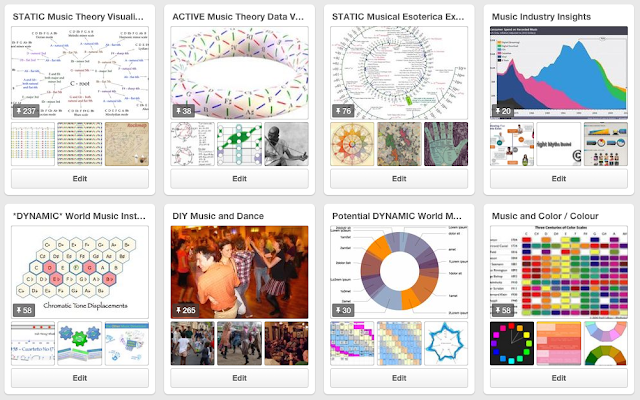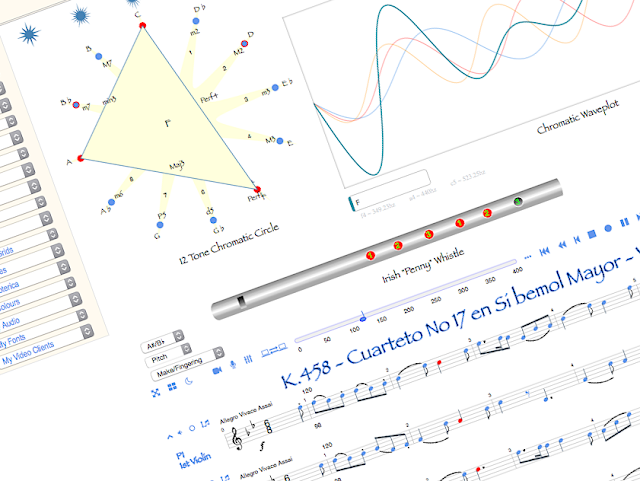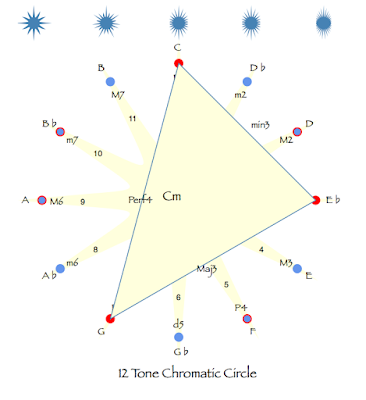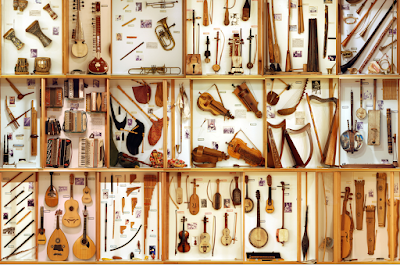Musical virtuosity: the ability to intuitively, freely and playfully navigate a genre's entire musical context (scales, their associated modes, characteristic ornaments and emotional dynamics) in a way that remains true to the expectations of a knowledgable, genre-native listener.
Given the multiple, layered challenges, it's little wonder learning an instrument is acknowledged as one of the few really effective brain training strategies.
Until now (and given enough motivation), for the enthusiast, musical virtuosity was founded years of practice, listening and rather haphazard knowledge gathering.
Central to accelerating this? The right tools, expert advice, direct access to outstanding role models, and increasingly, exploiting understanding of the brain and the core mechanisms of learning.
Yet even as artificial intelligence and machine learning take off, exploitation of the web browser's visualization capabilities -perhaps the most direct path to structured learning- has barely begun.
Without taking this initial step, of revealing world music's many treasures in graphical form, we have no way of integrating a host of other learning advances.
World music's underlying structures are global, cross-cultural and timeless. Help us get them animated, discovered, and put to use by the world's great teachers and ethnic virtuosos.
'Potential Crowd Funder' registration? Further below..
Big, brave, open-source, non-profit, community-provisioned, cross-cultural and bat cave crazy. → Like, share, back-link, pin, tweet and mail. Hashtags? For the crowdfunding: #VisualFutureOfMusic. For the future live platform: #WorldMusicInstrumentsAndTheory. Or just register as a potential crowdfunder..
Musical Visualisation
When learning to play a musical instrument, we currently engage three learning modes:
The last that is of particular interest to us here. Without the integration, synchronization and animation of the full range of world music instruments and theory models, it will never realize it's full teaching and learning potential.
Musicians hear songs when they read music, non-musicians seek visual patterns.
Visuals are processed 60,000 times faster than text by the human brain. 90% of information transmitted to the brain is visual.
How many pages of text would would be needed to convey all the information in the diagram to the left?
If this easy, why is data visualization hardly used in music teaching? Why not expose everything in animated, visual form?
In providing advanced, score-driven, interactive models for instruments and music theory, we can satisfy clear learning and teaching needs - from beginner right through to musical virtuoso.
A Galaxy of Musical Opportunity
In driving animations directly from exchange formats such as MusicXML or audio, a vast constellation of new, entirely dynamic practice and learning applications is made accessible:
This new transparency and modeling reach will fuel further knowledge advancement, mutual understanding and accessibility, helping to protect existing musical diversity, enhance the teacher's role, accelerate new learner progress and promote hitherto undreamed-of musical experiment.
A Roadmap to Virtuosity
There is no such thing as invention in isolation from all else going on around us. As part of the preparation for this project, we gathered a huge range of openly available, example information on instrumental and theory tool modeling. The vehicle chosen for this was Pinterest.
These are simply intended to provoke thought about what might be missing. If you spend any time at all amongst these, you will agree there is *vast* potential for social value generation.

A Few Of Our Pinterest Pinboards
Dedicated to World Music Visualisation
Our goal is, in effect, to unite all the areas suggested by the above into one coherent and entirely customizable platform.
The following diagram attempts to show the way forward. Our current position is at the threshold between blue and cream areas, the medium term goal person-to-person teaching and learning worldwide.
I see this as fostering, in it's own way, both diversity and virtuosity. As shown in the diagram, however, there is another dimension: that of peer-to-peer connectivity. This is dealt with in a separate post. Can you find it? :-)
Keywords
online music learning,
online music lessons
distance music learning,
distance music lessons
remote music lessons,
remote music learning
p2p music lessons,
p2p music learning
music visualisation
music visualization
musical instrument models
interactive music instrument models
music theory tools
musical theory
p2p music interworking
p2p musical interworking
comparative musicology
ethnomusicology
world music
international music
folk music
traditional music
P2P musical interworking,
Peer-to-peer musical interworking
WebGL, Web3D,
WebVR, WebAR
Virtual Reality,
Augmented or Mixed Reality
Artificial Intelligence,
Machine Learning
Scalar Vector Graphics,
SVG
3D Cascading Style Sheets,
CSS3D
X3Dom,
XML3D
ANY: Music System ◦ Score ◦ Voice ◦ Instrument Or Theory Tool Config ◦
World Music's DIVERSITY and Data Visualisation's EXPRESSIVE POWER collide. A galaxy of INTERACTIVE, SCORE-DRIVEN instrument model and theory tool animations is born.
Entirely Graphical Toolset Supporting World Music Teaching & Learning Via Video Chat ◦ Paradigm Change ◦ Music Visualization Greenfield ◦ Crowd Funding In Ramp-Up ◦ Please Share
Featured Post
All Posts (*** = Recap)
- User Environment - Preferences and Population
- Comparative Musicology & Ethnomusicology
- Music Visualisation - a Roadmap to Virtuosity ***
- A Musical Instrument Web Repository
- Toolset Supported Learning Via Video Chat
- Key Platform Features ***
- Platform Aspirations
- Aggregator Platform vs Soundslice
- Music, Machine Learning & Artificial Intelligence
- World Music Visualisations And The 3D Web
- Cultivating Theory Tool Diversity
- Cultivating Instrumental Diversity
- Cultivating Notation Diversity
- Cultivating Music System Diversity
- One URL To Animate Them All And In The Browser Bind Them ***
- Music Visualisation: Platform Overview
- Music Visualisation: Challenges
- Music Visualisation: The Key To Structure
- Music Visualisation: Motivation ***
- Music Visualisation: Key Concepts ***
- Music Visualisation: Social Value
- Music Visualisation: Prototype
- Music Visualisation: Catalysts
- Music Visualisation: Platform Principles
- Music Visualisation: Here Be Dragons
- Music Visualisation: Potential
- Music Visualisation: The Experimental Edge
- Music Visualisation: Business Models
- Music Visualisation: Technical Details
- Music Visualisation: (Anti-)Social Environment
- Music Visualisation: Arts, Crafts, Heritage
- Music Visualisation: Politics
- Music Visualisation: Benefits ***
- PROJECT SEEKS SPONSORS
- Consistent Colour Propagation
- Orientation: Genre-Specific Workflows
- P2P Teacher-Student Controls
- Musical Modelling
- Social Media Integration
- Platform Provisioning In Overview
- Generic to Specific Modelling: A Closer Look
- Notation, Standardisation and Web
- Communication: Emotional vs Technical
- Musical Storytelling
- Product-Market Fit
- Monthly Challenge
- World Music Visualisations and Virtual Reality
- World Music Visualisations: Paradigm Change?
- How Does It All Work Together?
- Off-the-Shelf Animations: Musical Uses
- MVC vs Data Driven
- A Reusable Visualisation Framework
- What IS Music Visualisation?
- Questions Music Visualisations Might Answer
- Google Group for World Music Visualisation
- Instrument Visualization: Fingering Controls
- Static, Active, Interactive, Timeline-Interactive
- Visualising Instrument Evolution
- Unique Social Value (USV)
- Instrument Modelling: Lute Family
- Person-to-Person ('P2P') Music Teaching
- Alternative Music Visualizer Scenarios
- Music Visualisation: Why a platform, not just an app?
- Music, Dance and Identity: Empowerment vs Exploitation
- Why No Classification System For Music Theory?
- Musical Heritage, Copyright and Culture
- Visualisation Aggregator Platform - Musical Immersion
- Instrument Models - Complete Configuration Freedom
- Diversity is Health, Contentment is Wealth
- Politics & Provisioning Mechanisms of World Music Learning
- Technology, Tribes, Future and Fallout
- Rule-Based vs Data-Driven Notation
© Copyright 2015 The Visual Future of Music. Designed by Bloggertheme9 | Distributed By Gooyaabi Templates. Powered by Blogger.
![By Enas El Masry (Own work) [CC BY-SA 4.0 (http://creativecommons.org/licenses/by-sa/4.0)], via Wikimedia Commons Oud class at Cairo's Beit el-Oud (House of Oud)](https://2.bp.blogspot.com/-BtTep2I3fN8/WbfUEpxFB7I/AAAAAAAAEtM/GqYgVTGLAsIVQCCON8XJvrnCOgTR9hFnQCLcBGAs/s320/Oud_class_at_Cairo%2527s_Beit_el-Oud_%2528House_of_Oud%2529-480x320-compressed.png)





Comments, questions and (especially) critique welcome.